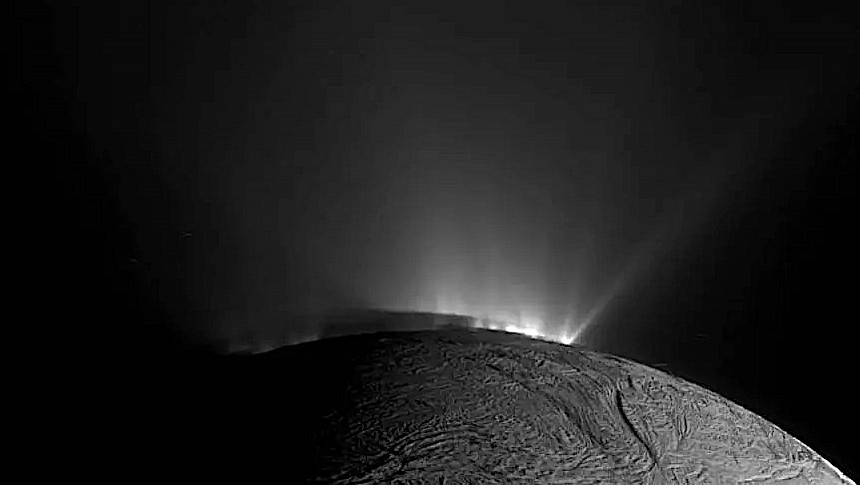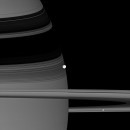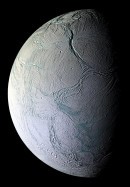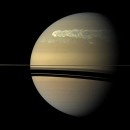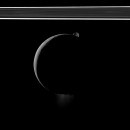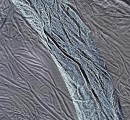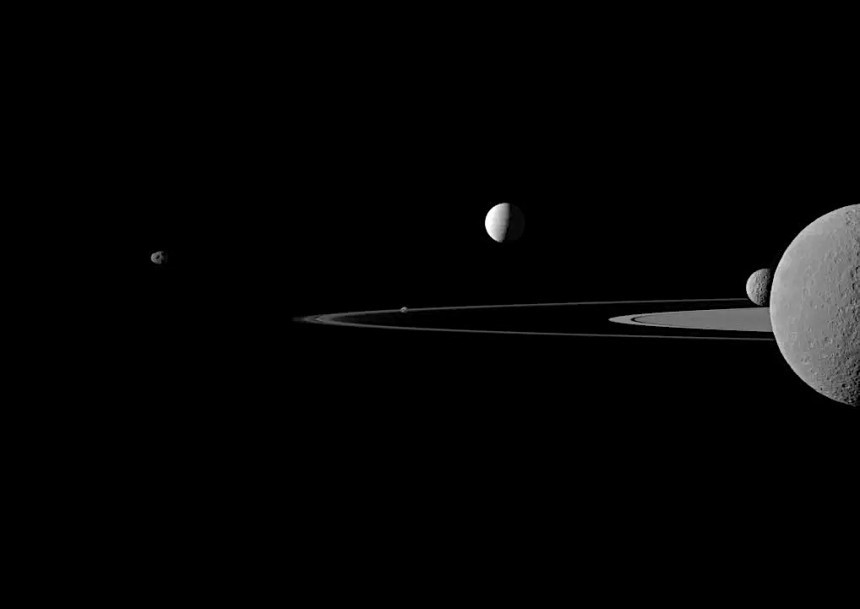Knowing what we know now about our solar system, it would be fair to assume that many of the processes and state of affairs we've observed here with our own instruments and eyes are widespread throughout the Universe.
For instance, we've recently discussed at length a discovery concerning one of the moons in the solar system that has one of the biggest chances of harboring life in our immediate neighborhood.
It's Enceladus I'm talking about, a place we already knew to have a massive water ocean underneath its icy crust. We know this thanks to the moon's habit of blasting that ocean into space through geyser-like jets of water vapor and ice particles, and thanks to the presence in its vicinity at one point of a spacecraft called Cassini, which observed and studied all of this.
There are a handful of other moons in Sol with the same traits (of a total of about 290 such celestial bodies we know about), so Enceladus is not an exception, but probably a rule. A rule that may very well expand beyond the borders of our system and well into the wider galaxy.
At least that's what NASA makes us believe through a new study it conducted that shows that some of the exoplanets we've already discovered "could have oceans of liquid water, an essential ingredient for life, beneath icy shells." And not only that, but just like in the case of Enceladus but also Jupiter's moon Europa, "water from these oceans could occasionally erupt through the ice crust as geysers."
The study was published back in October in the Astrophysical Journal and was led by Dr. Lynnae Quick of NASA's Goddard Space Flight Center, who presented it this month at the American Geophysical Union meeting in San Francisco, California.
During the research, the team looked at 17 confirmed exoplanets, all of them about the size of our own planet but less dense, a trait that may point to them being home to large amounts of water. They are also much colder than our home world, which may mean they are covered in ice.
These places, including planets Proxima Centauri b, Kepler 441b, LHS 1140, and MOA 2007 BLG 192Lb, pair the possible presence of ice on their surface with enough internal heat, coming from the decay of radioactive elements and tidal forces, to possibly allow for the presence of liquid water underneath the icy shell.
The combination of the coldness of the exterior and the hotness of the subsurface may cause the planets to generate geysers of their own, just like Enceladus. And this study also managed to calculate, for the first time ever, just how much geyser activity these exoplanets might experience.
And they found that some of these eruptions might be powerful enough to be observed with nothing more than a telescope on the lookout for brightness and reflections. In the case of Proxima Centauri b, for instance, eruptions could spit out into space as much as 13.2 million pounds (six million kg) of water vapor, ice, and God knows what else per second, while LHS 1140 releases 639,640 pounds (290,000 kg) per second.
Just to put things into perspective, consider the fact the largest such geysers we know of here in our solar system, the ones on Europa, release only 4,400 pounds (2,000 kg) per second.
As for the thickness of the shell of ice that covers these exoplanets, astronomers were capable of calculating there is a 190 feet (58 meters) wall of ice covering Proxima Centauri b, one mile (1.6 km) of the stuff over LHS 1140 b, and no less than 24 miles of ice depth for MOA 2007 BLG 192Lb. As you can see, the thinner the ice crust, the more powerful the geysers.
This discovery is important not only because it moves us one step closer to acknowledging the possibility of life existing outside our solar system, but also because it proves life could be much more widespread than we could have ever dreamed of.
You see, astronomers generally look for signs of life in the so-called Goldilocks zone of solar systems, the place far and close enough at the same time to the sun to allow for the existence of liquid water on rocky worlds.
Ice planets and moons, on the other hand, are generally located much further out than that, but as this study shows, under the right conditions (the main one being the existence of some kind of internal heat source) they too could support life.
Further study into these planets is of course needed to determine whether the water vapor jettisoned into space could contain the ingredients for life (yes, we can do that from this far out, using the means at our disposal).
And circling back to how we started all this, assuming many of the processes and state of affairs we've observed in our own solar system are commonplace, then probably so is life. Wouldn't that be something?
It's Enceladus I'm talking about, a place we already knew to have a massive water ocean underneath its icy crust. We know this thanks to the moon's habit of blasting that ocean into space through geyser-like jets of water vapor and ice particles, and thanks to the presence in its vicinity at one point of a spacecraft called Cassini, which observed and studied all of this.
There are a handful of other moons in Sol with the same traits (of a total of about 290 such celestial bodies we know about), so Enceladus is not an exception, but probably a rule. A rule that may very well expand beyond the borders of our system and well into the wider galaxy.
At least that's what NASA makes us believe through a new study it conducted that shows that some of the exoplanets we've already discovered "could have oceans of liquid water, an essential ingredient for life, beneath icy shells." And not only that, but just like in the case of Enceladus but also Jupiter's moon Europa, "water from these oceans could occasionally erupt through the ice crust as geysers."
The study was published back in October in the Astrophysical Journal and was led by Dr. Lynnae Quick of NASA's Goddard Space Flight Center, who presented it this month at the American Geophysical Union meeting in San Francisco, California.
During the research, the team looked at 17 confirmed exoplanets, all of them about the size of our own planet but less dense, a trait that may point to them being home to large amounts of water. They are also much colder than our home world, which may mean they are covered in ice.
The combination of the coldness of the exterior and the hotness of the subsurface may cause the planets to generate geysers of their own, just like Enceladus. And this study also managed to calculate, for the first time ever, just how much geyser activity these exoplanets might experience.
And they found that some of these eruptions might be powerful enough to be observed with nothing more than a telescope on the lookout for brightness and reflections. In the case of Proxima Centauri b, for instance, eruptions could spit out into space as much as 13.2 million pounds (six million kg) of water vapor, ice, and God knows what else per second, while LHS 1140 releases 639,640 pounds (290,000 kg) per second.
Just to put things into perspective, consider the fact the largest such geysers we know of here in our solar system, the ones on Europa, release only 4,400 pounds (2,000 kg) per second.
As for the thickness of the shell of ice that covers these exoplanets, astronomers were capable of calculating there is a 190 feet (58 meters) wall of ice covering Proxima Centauri b, one mile (1.6 km) of the stuff over LHS 1140 b, and no less than 24 miles of ice depth for MOA 2007 BLG 192Lb. As you can see, the thinner the ice crust, the more powerful the geysers.
This discovery is important not only because it moves us one step closer to acknowledging the possibility of life existing outside our solar system, but also because it proves life could be much more widespread than we could have ever dreamed of.
Ice planets and moons, on the other hand, are generally located much further out than that, but as this study shows, under the right conditions (the main one being the existence of some kind of internal heat source) they too could support life.
Further study into these planets is of course needed to determine whether the water vapor jettisoned into space could contain the ingredients for life (yes, we can do that from this far out, using the means at our disposal).
And circling back to how we started all this, assuming many of the processes and state of affairs we've observed in our own solar system are commonplace, then probably so is life. Wouldn't that be something?
